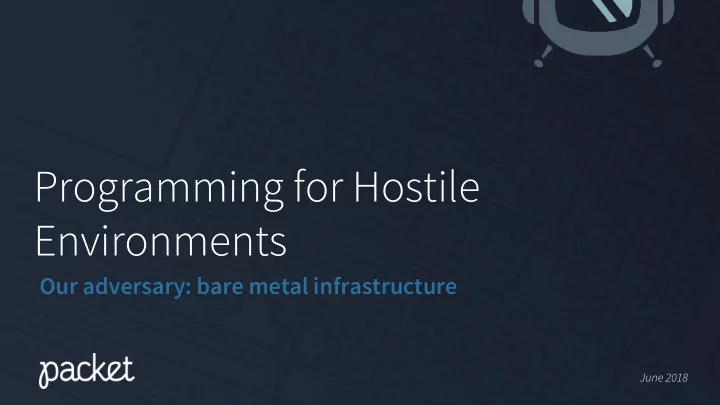

Programming for Hostile Environments Our adversary: bare metal infrastructure June 2018
About Me Nathan Goulding, SVP Engineering ~15 years frontline engineer for infrastructure/cloud and media companies Currently lead engineering team at Packet me = n+3 @NathanGoulding / nathan@packet.net
What Packet Does “serverless” We automate bare metal, physical infrastructure (still runs on a server) Founded in 2014 by infrastructure geeks Over 15,000 users APP x86 and ARM CPU architectures 16 locations around the world CONTAINER 20 supported operating systems HYPERVISOR 50,000 installs per month SERVERS @NathanGoulding / nathan@packet.net
“DRIVERLESS” @NathanGoulding / nathan@packet.net
Programming for Hostile Environments Topics we’ll cover: Transitioning from monolith (ruby) to microservices (golang) Turning antipatterns into patterns Applied best practices Goals we set for ourselves Ephemeral nanoservices @NathanGoulding / nathan@packet.net
Hostility of the Environment APP CONTAINER HYPERVISOR SERVER @NathanGoulding / nathan@packet.net
The Problem, Abstract packet.net / @packethost
Out-of-band Datacenter #1 DHCP Power Control VPN PORTAL Bare metal racks Metadata OS Images REST API Out-of-band Datacenter #2 IPAM DHCP DNS Power Control VPN Bare metal racks Metadata OS Images @NathanGoulding / nathan@packet.net
From monolith to microservices API MAGNUM IP PB&J TINKERBELL KANT OSIE Multi-Tenant Power and DHCP & iPXE EC2 Style In Memory Internal and IPAM Boot Control Server Metadata Installation External Services Environment Client Portal S.O.S DOORMAN SOREN NARWHAL PENSIEVE Device, Project, Billing, Serial Console Customer Sflow Agg Physical Switch Forward and Out of Bound Token Management & Analysis Automation Backend rDNS Access VPN @NathanGoulding / nathan@packet.net
Moving to golang Compiled Static typing Very little “magic” The best of prior programming languages minus the cruft @NathanGoulding / nathan@packet.net
An emerging pattern
An emerging pattern @NathanGoulding / nathan@packet.net
Best Practices, in Practice #1 - gRPC for communication / rpc #2 - Get your data as close to where you need it as quickly as possible #3 - Don’t hide code you don’t like @NathanGoulding / nathan@packet.net
#1 gRPC for communication / rpc Handles backoff / retry Straightforward service definition for request / response Streaming data and authentication via SSL Paradigm for dealing with message format changes packet.net / @packethost
#2 Get data close to where it needs to be, quickly The network is unreliable, the network is unreliable, the network is unreliable Speed up access times + experience for everyone Be careful of “I’ll just request it (remotely) whenever I need it” packet.net / @packethost
#3 Don’t hide code you don’t like Don’t use interfaces / providers to hide code you wish didn’t exist Use drivers / implementations where it counts packet.net / @packethost
Why Does it Matter? @NathanGoulding / nathan@packet.net
Goal #1: Can we provision in under 60 seconds? @NathanGoulding / nathan@packet.net
Provisioning Timing Distribution @NathanGoulding / nathan@packet.net
Provisioning Timeline @NathanGoulding / nathan@packet.net
@NathanGoulding / nathan@packet.net
Ephemeral Nanoservices Function Job Nanoservice Microservice Monolith Ephemeral ✓ ✓ ✓ ✕ ✕ Encapsulated ✓ ✓ ✓ ✓ ✕ Logging ? ✓ ✓ ✓ ✓ Complex tasks ✓ ✓ ✓ ✓ ✕ Monitored ✓ ✓ ✓ ✕ ✕ @NathanGoulding / nathan@packet.net
Nanoservice Use Cases Services that have complex tasks or functionality to perform, and... Need to communicate with other services, and... Need to be kept up and running, but... Will never be used past their “life” Analogy: an ephemeral nanoservice is an “instantiation” of a microservice @NathanGoulding / nathan@packet.net
Goal #2: Can we go a full day without a single provisioning failure? @NathanGoulding / nathan@packet.net
@NathanGoulding / nathan@packet.net
What’s next? #1 - Flexible workflows via directed graphs #2 - Distributed tracing for service logs @NathanGoulding / nathan@packet.net
Q&A (we're hiring) @NathanGoulding / nathan@packet.net
Recommend
More recommend